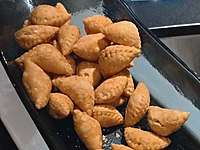Yau gok
This article needs additional citations for verification. (August 2012) |
 | |
| Alternative names | Gok zai (角仔) |
|---|---|
| Course | Chinese New Year dish |
| Place of origin | China |
| Region or state | Guangdong, Hong Kong and Cantonese-speaking areas |
| Main ingredients | glutinous rice dough, various meat fillings |
| Yau gok | |||||||||||||||||
|---|---|---|---|---|---|---|---|---|---|---|---|---|---|---|---|---|---|
| Chinese | 油角 | ||||||||||||||||
| Literal meaning | oil dumpling | ||||||||||||||||
| |||||||||||||||||
| Alternative Chinese name | |||||||||||||||||
| Chinese | 角仔 | ||||||||||||||||
| Literal meaning | small dumpling | ||||||||||||||||
| |||||||||||||||||
Yau gok or jau gok are traditional dumplings found within Cantonese cuisine originating from Guangdong Province in China. They are most common during Chinese New Year and are consumed in Cantonese-speaking regions and communities, including Hong Kong and Malaysia.
Names[]
This section does not cite any sources. (January 2021) |
There are quite a number of unofficial English names associated with this dish:
- Oil dumplings
- Peanut Puff
- Crispy triangles
- Fried oil dumplings
- New year dumplings
- Chinese new year dumplings
- Oil horn
- Pot stickers
Origin[]
Yau gok were shaped to resemble money. These dumplings look just like ancient forms of Chinese currency, like the sycee. That's why those who follow the Taoist religious philosophy believe that eating one brings good fortune.[1]
Preparation[]
The dumpling wrap is first made of glutinous rice dough. A dumpling shape is formed, and then a batch of dumplings are deep fried in a wok.[2]
Salty[]
The savory version are generally called haam gok zai (simplified Chinese: 咸角仔; traditional Chinese: 鹹角仔; pinyin: xián jiǎo zǐ; Jyutping: haam4 gok3 zai2). There is a range of popular fillings that varies depending on regional culture. Common ingredients include pork, pieces of Chinese sausages, pieces of Chinese black mushroom.
Sweet coconut[]
The sweet coconut version are generally called tim gok zai (Chinese: 甜角仔; pinyin: tián jiǎo zǐ; Jyutping: tim4 gok3 zai2). The standard filling has desiccated (dried) coconut crumbs mixed with sugar. After the frying, this version is crunchy. This version is suitable for vegetarians.
See also[]
- Jiaozi
- Jian dui
- List of deep fried foods
References[]
- ^ "Food and Religion : Symbolism and Origins of Religious Food Traditions : Photos : Cooking Channel". Retrieved 2016-07-15.
- ^ wantanmien (2012-01-14). "Chinese new year Yau kwok, 油角 (Cantonese)". youtube.com. Archived from the original on 2021-12-21. Retrieved 14 August 2012.
- Cantonese cuisine
- Cantonese words and phrases
- Chinese New Year foods
- Deep fried foods
- Dim sum
- Dumplings